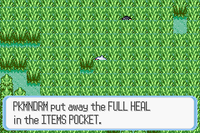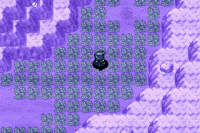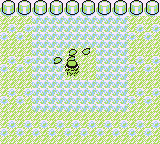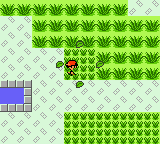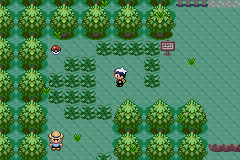Tall grass

|
This article is incomplete. Please feel free to edit this article to add missing information and complete it. Reason: Generation section, BDSP and SwSh models and information |
Tall grass (Japanese: 草むら tall grass) is a mechanic in the core series Pokémon games, and the habitat for many species of wild Pokémon. In games prior to Pokémon Legends: Arceus, a wild Pokémon may appear and begin to battle the player if they are moving through tall grass.
Tall grass is found on most routes of the Pokémon world, with some routes containing more tall grass patches than others. If the player enters a patch of tall grass, they may randomly enter a wild Pokémon battle. People are warned to stay out of tall grass if they don't own a Pokémon, due to the possibility of being attacked by wild Pokémon. In Pokémon Legends: Arceus, as wild Pokémon are encountered out in the open, moving through tall grass instead serves to make the player less visible to wild Pokémon. Pokémon Scarlet and Violet are the only core series games in which tall grass has no gameplay effect whatsoever.
In Generation I and Generation II, using Cut causes the tall grass tile directly in front of the player to be cut down. In Generation III, this instead cuts down a 3 by 3 area around the player; in Pokémon Emerald only, a Pokémon with Hyper Cutter will cut down a 5 by 5 area by using Cut. In Generation II, long grass, such as that in the National Park, requires multiple uses to be cut down; in Generation III, it is instantaneous. From Generation IV onward, Cut has no effect on tall grass.
Differences between games
|
Technical mechanics
Poké Radar

|
This section is incomplete. Please feel free to edit this section to add missing information and complete it. Reason: Generation VI |
- Main article: Poké Radar
The Poké Radar is a device introduced in Generation IV that is used to seek out wild Pokémon hiding in long grass. If the Pokémon that is found is knocked out or captured in a Poké Ball, a chain will begin. These chains consist of multiple members of the same Pokémon species encountered one after another. The only catch is this: a player must not encounter any Pokémon just by walking through non-wiggling grass, only by walking into the grass that shakes. Therefore, it is recommended that Repel is used in order to ensure this and achieve a higher chain. Entering the same type of grassy patch the chain was started in that is the farthest away increases the chances of meeting the same kind of Pokémon consecutively. Long chains increase the chance of finding a Shiny Pokémon, which is indicated by the patch of grass glowing white twice rather than shaking. In Generation IV, long grass does not shake when the Poké Radar is used.
Alternative areas

|
This section is incomplete. Please feel free to edit this section to add missing information and complete it. Reason: Long rustling grass; tall flowers |

|
The picture used in this section is unsatisfactory. Please feel free to replace it so it conforms to Bulbapedia conventions. Reason: Check dark long grass images in B2W2 |
Long grass
Long grass (Japanese: 長い草むら long grass) is a type of tall grass that is taller than usual. These patches of grass have grown longer than the usual grass patches, containing different species of Pokémon. Long grass was introduced in Generation II. From Generation III until Generation VI, it is impossible to ride a bicycle through this type of grass (and impossible to run through it in Generation III). Some Trainers hide in the long grass patches, concealing themselves from view and surprising the player to a battle. In Pokémon Diamond, Pearl, and Platinum, long grass raises the relative encounter probability per step by the same amount a Bike would in regular tall grass, while in Pokémon HeartGold and SoulSilver, it increases by slightly less while walking and slightly more when running. Specifically, in the former, long grass increases the movement part of the formula from 40 to 70, while in latter it increases it from 20 to 60, which then can be increased further to 80 by running the long grass.
It appears in the following locations.
- Johto: National Park
- Hoenn: Route 119, Route 120, Route 121ORAS, and the Hoenn Safari ZoneORAS
- It also appears on Faraway Island.
- Sinnoh: Route 210 and Route 214
- Unova: Route 7
- Kalos: Route 6 and Route 16
- Alola: Lush Jungle and Ula'ula Meadow
In Generation V, long grass can be normal or dark, functioning just like tall grass: phenomena can occur in normal long grass, while Double Battles can occur in dark long grass.
|
Seaweed
Seaweed (Japanese: 海草 sea grass) is located underwater in Hoenn as an underwater equivalent to tall grass on land. In Pokémon Ruby, Sapphire, and Emerald, seaweed can be found underwater on Routes 124 and 126. In Pokémon Omega Ruby and Alpha Sapphire, it appears underwater on Routes 107, 124, 126, 128, 129, and 130. The chance of encountering Pokémon in seaweed is lower than that of tall grass.
|
Dark grass
Dark tall grass (Japanese: 濃い色の草むら dark tall grass) is exclusive to Generation V. In dark grass, not only are Pokémon found usually at much higher levels than those in regular grass, but there is a chance of encountering two wild Pokémon at a time, in a Double Battle. Pokémon encountered in dark grass are often similar to those found in normal grass areas of the route, but not identical (in particular, Pokémon encountered in dark grass may be slightly more difficult to catch). Often, Pokémon which are rare in normal grass are more common in dark grass. Pokémon encountered in dark grass may also have a 1% chance of holding a special item.
Patches of dark grass are typically separated from patches of normal grass. Dark grass does not rustle. There is also long dark grass, which behaves like both types of grass simultaneously.
|
Rustling grass
- Main article: Phenomenon
Rustling grass (Japanese: 揺れる草むら rustling tall grass) is found in Generation V, in virtually any area with patches of tall grass. Occasionally, a patch of grass can be seen shaking. Entering such a patch triggers a battle with a wild Pokémon. The Pokémon found in rustling grass differ from route to route, but all areas (except Route 19) contain Audino. In most areas, it is possible to encounter in rustling grass the evolved forms of Pokémon found in regular grass. Regular tall grass has a chance to start rustling for every step the player takes. Rustling grass will stop shaking if the player enters a battle, or if they leave the area (even if that specific grass patch remains on the screen). Dark grass does not rustle.
|
Flowers
Flowers (Japanese: 花畑 flower bed) are a kind of overworld tile introduced in Generation VI that function like tall grass. The Pokémon that can be found in one color of flowers may be different than those found in another color or in tall grass; especially with Flabébé (whose flower generally matches which patch it is found in). In Kalos, flowers can be yellow, red, or purple; in Alola, they can only be yellow or red.
Flowers that yield wild Pokémon appear in the following locations.
- Kalos: Routes 4, 7, 8, 10, 12, 15, 16, 18, 19, 20, 21, and 22, along with the Pokémon Village
- Alola: Melemele Meadow and Ula'ula Meadow
|
In battle
Certain moves have special effects when used in a battle on a grass tile.
- Secret Power
- In Generation III
- In tall grass: has a 30% chance of poisoning its target and the appearance of Needle Arm
- In long grass: has a 30% chance of putting its target to sleep and the appearance of Magical Leaf
- In seaweed: has a 30% chance of lowering its target's Defense and the appearance of Waterfall
- In Generations IV and V: has a 30% chance of putting its target to sleep and the appearance of Needle Arm
- In Generations VI and VII: has a 30% chance of putting its target to sleep and the appearance of Vine Whip
- In Generation III
- Nature Power
- In Generation III
- In tall grass: turns into Stun Spore
- In long grass: turns into Razor Leaf
- In seaweed: turns into Hydro Pump
- In Generations IV and V: turns into Seed Bomb
- In Generations VI, VII, and VIII: turns into Energy Ball, or Earth Power only in the Crown Tundra
- In Generation III
- Camouflage
- In grass: makes the user Grass-type
- In seaweed: makes the user Water-type
Cutting grass

|
This section is incomplete. Please feel free to edit this section to add missing information and complete it. Reason: Add also an example of cutting grass with Hyper Cutter in Emerald |
In spin-off games
Pokémon UNITE
In Pokémon UNITE, tall grass appears in all of the game's stages except for Panic Parade. Unlike in the main series, tall grass is unrelated to the function of wild Pokémon. Instead, Pokémon can hide within the tall grass. Standing in tall grass prevents players from the opposing team from seeing the Pokémon unless both players are next to each other. (Wild Pokémon are invisible to the Pokémon of both teams.)
Some effects interact with tall grass. Comfey's Unite Move, Flowery Fields Forever, creates tall grass. Its Triage Ability triggers when it enters tall grass, allowing Comfey to collect flowers. Goodra's Gooey Ability allows it to recover HP for a short amount of time when entering tall grass. Inteleon's Unite Move, Azure Spy Vision, allows it to see opposing Pokémon in tall grass. Leafeon's Chlorophyll Ability only fills its gauge while Leafeon is not in tall grass. Mimikyu's Shadow Sneak extends farther from Mimikyu if the move goes through tall grass. Meowscarada's Trailblaze has increased range when Meowscarada is standing in tall grass. While hidden in tall grass, opponents can still receive damage. However, moves that require a target cannot be performed against Pokémon hidden in tall grass. Some attacks, such as Comfey's Magical Leaf, can target opponents hidden within tall grass.
Trivia
- The myth "Sinnoh Region's Mythology" detailed in the Canalave Library, as well Old Verse 19, explains why Pokémon appear in tall grass. According to the myth, Pokémon appear in tall grass in order to help humans, due to a deal made long ago.
In other languages
Tall grass
| |||||||||||||||||||||||||||||||||||||
Long grass
| |||||||||||||||||||||
Dark tall grass
| |||||||||||||||||||||
Rustling grass
| |||||||||||||||||||||
| Special tiles in the Pokémon games |
|---|
| Cave tile • Hole • Ice tile • Ledge • Marsh tile • Puddle • Sand tile • Snow tile Spin tile • Soft soil • Tall grass • Trap • Warp tile • Water tile Dungeon tile |

|
This game mechanic article is part of Project Games, a Bulbapedia project that aims to write comprehensive articles on the Pokémon games. |

